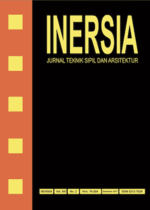DESAIN SABO DAM TIPE CONDUIT SEBAGAI PENGENDALI DAYA RUSAK ALIRAN DEBRIS
DOI:
https://doi.org/10.21831/inersia.v16i2.36897Abstract
ABSTRAKSungai Air Kotok di Kabupaten Lebong, Bengkulu memiliki litologi batuan yang rapuh akibat pengaruh panas bumi, kondisi tersebut menyebabkan rentan mengalami pergerakan massa tanah/batuan. Oleh karena itu, diperlukan upaya mitigasi untuk mengurangi risiko bencana dengan perencanaan bangunan pengendali aliran debris berupa sabo dam. Penelitian ini bertujuan untuk merencanakan desain sabo dam tipe conduit yang dirancang secara seri dan mengevaluasi stabilitas sabo dam berdasar SNI 2851:2015. Hasil perhitungan menunjukkan debit puncak untuk kala ulang 100 tahun sebesar 171,21 m3/detik. Empat seri sabo dam memiliki dimensi lebar pelimpah rerata ± 40 m, kedalaman aliran debris sebesar 1 m, dan tinggi pelimpah ialah 2,4 m. Stabilitas sabo dam saat banjir diperoleh faktor aman untuk stabilitas geser dan guling sebesar 3,46 ; 1,62. Adapun faktor aman terhadap pengaruh aliran debris untuk stabilitas geser dan guling adalah 3,30 ; 1,58. Berdasarkan hasil analisis, empat seri sabo dam tipe conduit yang dirancang mampu mengendalikan daya rusak banjir maupun aliran debris.
Kata kunci: Hidraulika sungai, aliran sedimen, bangunan sabo, stabilitas sabo
ABSTRACT
Air Kotok River in Lebong Regency, Bengkulu Province has the lithology of weathered rock which is a result of geothermal process, this condition causes to be susceptible to land / rock mass movements. Therefore, the mitigation efforts are needed to reduce the risk from disaster by design debris flow control such as sabo dam. This study aims to design series of conduit type sabo dam and evaluate the stability based on SNI 2851: 2015. The calculation shows that the peak discharge for the 100-year return period is 171.21 m3 / sec. The four sabo dam series have dimensions of spill width of ± 40 m, debris flow depth of 1 m, and overflow height of 2.4 m. The stability of sabo dam has safety factor in flood condition for shear and overturning stability are 3.46; 1.62, while in a debris flow condition for shear and overturning stability are 3.30; 1.58. Based on the results, the four series of conduit sabo dam are able to control the destructive power of floods and debris flows.
Key word: River hydraulic, sediment flow, sabo building, stability of sabo
Downloads
Published
How to Cite
Issue
Section
License
Authors who publish with INERSIA journal agree to the following terms:
- Authors retain copyright and grant the INERSIA journal right of first publication with the work simultaneously licensed under Creative Commons Attribution License (CC BY 4.0) that allows others to share the work with an acknowledgment of the work's authorship and initial publication in this journal.
- Authors can enter into separate, additional contractual arrangements for the non-exclusive distribution of the published version of the work (e.g., post it to an institutional repository or edit it in a book), with an acknowledgment of its initial publication in this journal.
- Authors are permitted and encouraged to post their work online (e.g., in institutional repositories or on their website) before and during the submission process, as it can lead to productive exchanges, as well as earlier and greater citation of published work.

INERSIA by https://journal.uny.ac.id/index.php/inersia was distributed under a Creative Commons Attribution 4.0 International License







